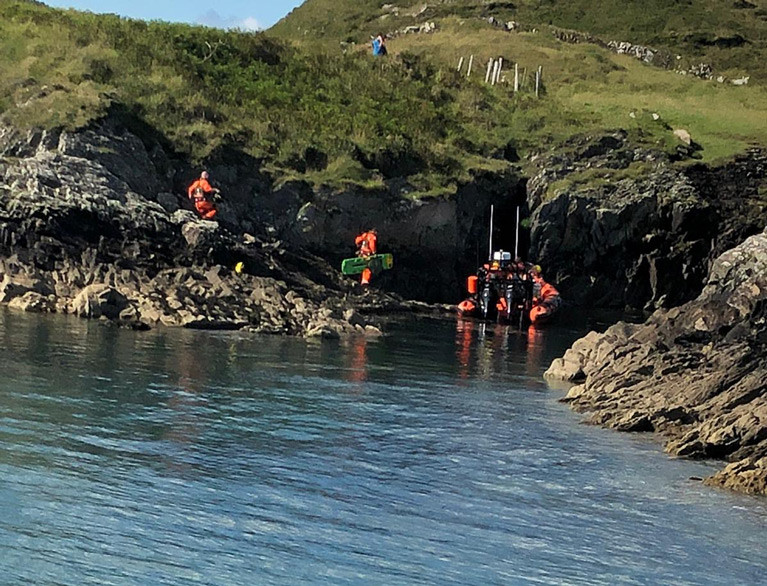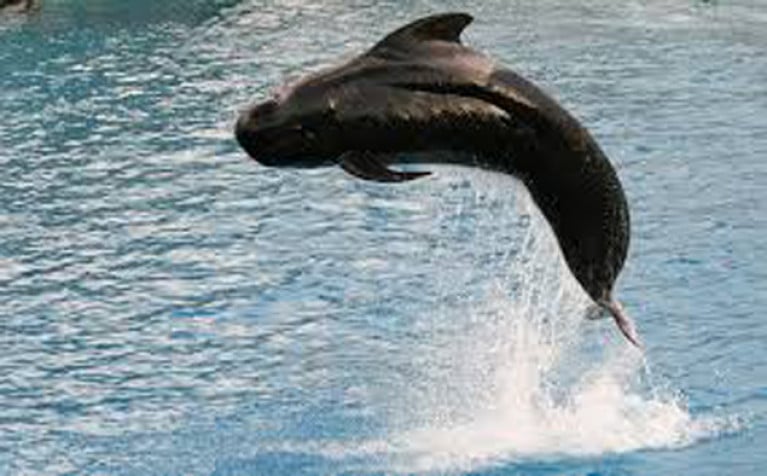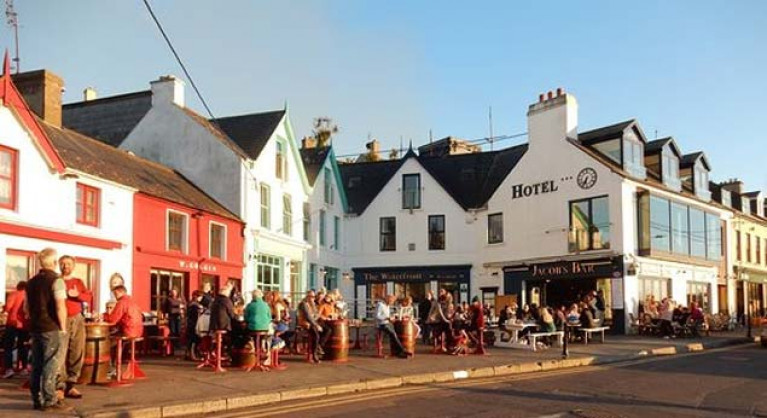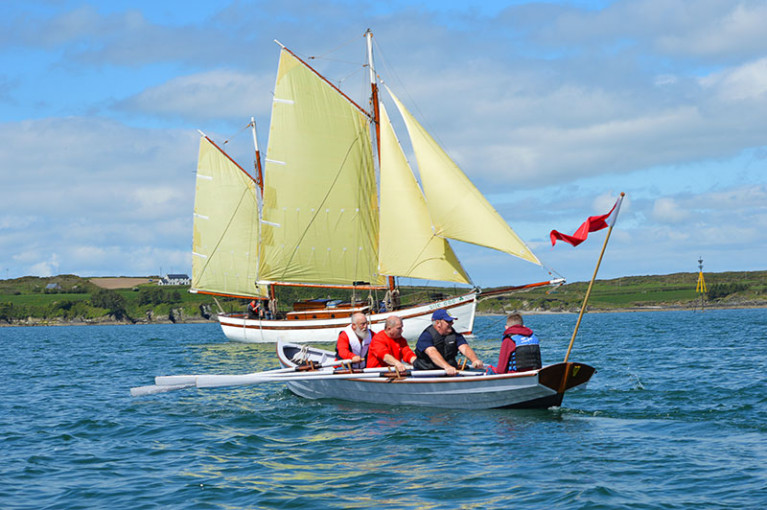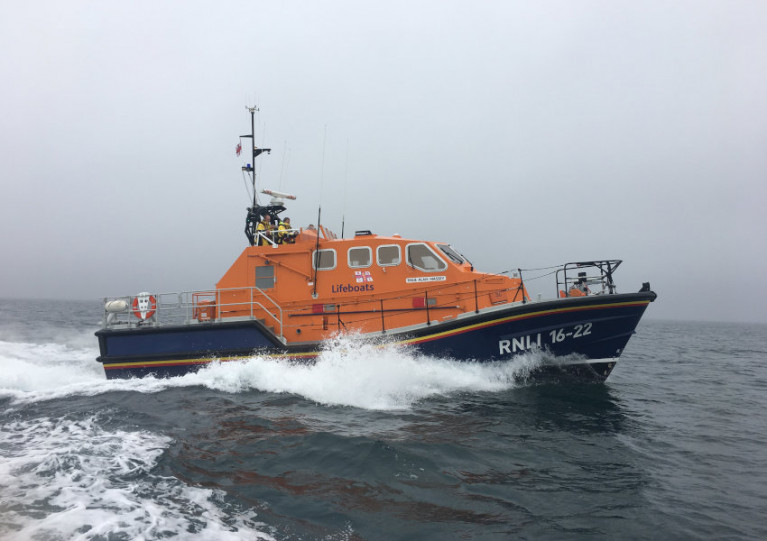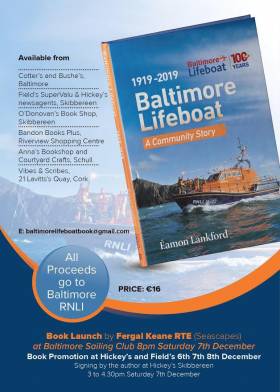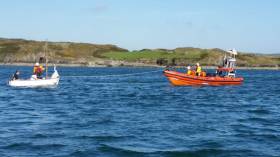Displaying items by tag: Baltimore
Baltimore Lifeboat Crew Rescue Teenage Girl Who Fell Down Blow Hole On East Skeam Island
Baltimore RNLI was called out to a medical evacuation earlier this evening (Thursday 9 July) after a teenage girl fell nearly 10 metres down a blow hole on East Skeam Island, off the coast of Baltimore in West Cork.
The volunteer lifeboat crew launched their all-weather lifeboat at 5.25 pm, following a request from the Irish Coast Guard to provide medical assistance and evacuation to the 17-year-old who had sustained injuries in the 30ft fall which left her "deeply shocked", according to RTÉ News.
The Baltimore all-weather lifeboat arrived at the island within 10 minutes of launching. A member of the public was already on the scene and Schull Coast Guard's rigid inflatable boat (RIB) arrived shortly afterwards, followed by the coastguard helicopter Rescue 115.
The RIB transferred two volunteer members of the Baltimore lifeboat crew, Emma Lupton and Jerry Smith, from the lifeboat to the cave.
After assessing the situation, the girl was placed on a stretcher and removed from the cave by the lifeboat and coast guard crew.
Extraction proved difficult as the cave was very narrow and there was a rising tide at the time. Once the casualty was safely transferred to the helicopter helicopter, the lifeboat then returned to the station in Baltimore at 7.18pm.
"Extraction proved difficult as the cave was very narrow and there was a rising tide"
There were five volunteer crew onboard the lifeboat: coxswain Kieran Cotter, mechanic Cathal Cottrell and crew members Jerry Smith, Emma Lupton and Sean McCarthy. Conditions at sea during the call out were calm with a north-easterly Force 2-3 wind, no sea swell and very good visibility.
Speaking following the callout, Kate Callanan, Baltimore RNLI volunteer lifeboat press officer, said: "If you find yourself in need of medical assistance whilst at sea or on an island, call 999 or 112 and ask for the coastguard. We wish the casualty a full recovery."
Was West Cork’s Tame Pilot Whale Ahead of his Time?
Whales, dolphins and porpoises hold a very special place in people’s hearts and minds. It may be a very long time since our shared mammalian ancestors went their respective ways, but when we get anywhere near “the cousins” in their watery world, there’s a special feeling. Particularly so when the individual involved is Fungi the bottlenose dolphin of Dingle, with his hopes for appreciative human company being stymied for now by the pandemic restrictions, even as his usual sociable season with its requirement for an appreciative audience moves towards its midsummer heights.
Those of us who have a gut feeling that the Covid-19 is going to be gone from Ireland like snow off a ditch by the end of May, well, we keep our notions to ourselves out of respect for the continuing heroic struggle of the frontline workers, and the specialists and those who provide them with management backup. And yes, we do accept that there’s a fair chance that it will return as autumn’s damp and cold and gloom descends on us. But in the meantime, there’s going to be a summertime window of opportunity, and we’ll all go mad if we don’t use it.
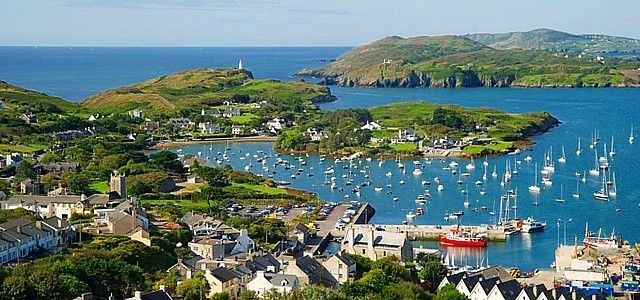 The Cove in Baltimore, where the pilot whale Albert was still an occasional presence in his final days in 1968
The Cove in Baltimore, where the pilot whale Albert was still an occasional presence in his final days in 1968
Meanwhile, the story of Fungi’s frustration here on Afloat.ie last week was clicking vigorously, as was Betty Armstrong’s subsequent story about a pod of orca whales in Strangford Lough. But there was an added dimension to the Fungi yarn, with our query as to whether anyone remembered Albert, the dolphin or pilot whale who used to make his home in and around Baltimore, and was into occasional interaction with moored cruising yachts. He reputedly enjoying the trick of gathering up the cruising folk’s ground tackle as they lay anchored for the night off Baltimore, and leaving them such that they woke up to find themselves anchored off Sherkin.
It was a memory which hit the spot among Afloat.ie viewers. Bells rang out, and pensioners danced in the streets - or more accurately, they leapt to their Smartphones and iPads, and we soon had enough facts and figures to form an Albert the Pilot Whale of Baltimore Club.
Brian Marten, well known for his work in the local community in West Cork and also for commissioning the re-birth of the 1893 Baltimore-built gaff cutter Eva as Guillemot by Liam Hegarty at Oldcourt, is right there with chapter and verse:
 Spirit of Baltimore: Brian Marten’s Guillemot – originally built as Eva in Baltimore in 1893 – is another successful Liam Hegarty restoration. Photo: Robbie Murphy
Spirit of Baltimore: Brian Marten’s Guillemot – originally built as Eva in Baltimore in 1893 – is another successful Liam Hegarty restoration. Photo: Robbie Murphy
“Sailing around Baltimore as a schoolboy, encounters with Albert were very common - he liked to hang around the Catalogues, (between Sherkin and Heir Island, west of Turk Head, I'm sure you know them). I often saw him jump clear out of the water one or more times in that channel. I recall seeing him jump out of the water near Sherkin when I was very small, one of my earliest memories. I believe that he disappeared some time in the late 1960's, probably died of old age. I don't think a carcass was ever reported.
He most definitely was not a dolphin, being much larger, probably at least 15ft to 18ft long as I recall. I usually saw him while in my brother Alan's National 18 (Alan Marten is currently co-owner of the classic River Class sloop Gweebarra in Strangford Lough, where he is a former Commodore of Strangford Lough YC).
People said Albert was a Pilot Whale, as you mention, but that may have been hearsay. There must have marine biologists around at the time who knew exactly what type he was. I say "he", as he was always referred to as masculine. Anyway, he never had babies, though to be fair that would have required two of the species.
We would usually hear him blowing in the harbour on a quiet night while walking back to the Cove from Dinny Salter’s (now Bushe’s).”
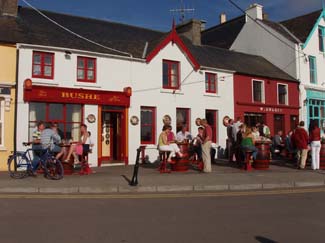 West Cork oasis – Bushe’s of Baltimore was still Dinny Salter’s when Albert the Pilot Whale was part of the local scene
West Cork oasis – Bushe’s of Baltimore was still Dinny Salter’s when Albert the Pilot Whale was part of the local scene
The proper slaking of thirsts in Baltimore was always a sensible priority, but right now the thirst is of the boats and their timberwork, and the challenge down there is to get the local fleet of traditional and classic wooden boats afloat as soon as possible after the Lockdown paralysis, which in recent weeks had been subjecting them ashore to excessive temperatures (both high and low) and searing sunshine
But as to Albert, it seems he was a Pilot Whale, and Brian’s estimate of a length of 15ft to 18ft (5.5 metres) hits the spot, whereas a bottlenose dolphin barely gets to 4 metres, though I’d say Fungi is all of that. Certainly, it means that if he were of a hostile nature, he could be a real menace, and a couple of years ago attempts to befriend and swim with a bottlenose dolphin at Doolin in County Clare went astray, with people being injured.
As for the leaping from the water, that seems to be both sheer exuberance, and the need to shake off sea lice. When a creature the size of Albert did it within the confines of Baltimore Harbour, it was quite something, but occasionally basking sharks do the same, and in recent years that inveterate ocean observer Youen Jacob of Baltimore has recorded basking sharks in the neighbourhood making their leap for freedom.
 He’s kind of all over the place, but at least he’s doing it – the rare sight of a basking shark jumping, as recorded by Youen Jacob of Baltimore. Photo: Youen Jacob
He’s kind of all over the place, but at least he’s doing it – the rare sight of a basking shark jumping, as recorded by Youen Jacob of Baltimore. Photo: Youen Jacob
Back in 1961 when I was cruising solo in a 23-footer off the west coast of Scotland, the word was out that basking sharks were a-leaping at the north end of Kilbrannan Sound between Arran and Kintyre. This was interesting – in the Chinese Mandarins’ interpretation of the word – as I wanted to sail up the Sound from Campbeltown to Tarbert, and sure enough off northwest Arran, there were some mighty splashes around. We – the little boat and me – were sailing along holding to the Kintyre shore thinking we were safe enough, when some eccentric biggie decided that this was exactly where he wanted to let his sea lice get off.
It seemed to me he jumped much more than the 1.2 metres which is all that basking sharks are supposed to achieve, suggesting he might have been a pilot whale. But either way, he was much too close for comfort, and I wasn’t in a species-identifying frame of mind, being just mighty glad there was only the one performance.
That night in the pub in Tarbert, the barman relished telling me that some years previously, there’d been another spate of shark-jumping in the same area. A boat only slightly larger than mine was sitting becalmed off Loch Ranza on the Arran shore, with two crew on board, when a very large basking shark or pilot whale shot blindly upwards out of the water and landed plumb on top of them, leaving only matchwood, with the bodies never found.
So maybe back in the 1930s, 40s, 50s and 60s when Albert was making the scene around Baltimore, it was common sense to accept that he was big enough to be accidentally dangerous, and anyway any notion of making him into a tourist attraction would generally have been out of kilter with the rather solemn mood of the time.
But his memory still evokes other memories, and former Baltimore Sailing Club Commodore Gerald O’Flynn wrote:
“Regarding your article on Fungi, you made reference to Albert who resided in Baltimore Harbour and its environs for many years. The late Tom Fuller, who was the founder of Baltimore Sailing Club in 1956, often told the story of Albert. He first became aware of Albert in the early '30s, and around that time he was asked by some local fishermen to "take care of that bastard!”
But Tom always thought he was an addition to the harbour, and always liked to be told when and where we saw him. Albert was a constant presence in the 50s and 60s, when he would suddenly loom up alongside, which was quite intimidating when aboard a National 12 dinghy.
My brother Dom was the last of our family to experience him - that was when he lived in the Cove around 1968. In bad weather, he said, you could hear Albert snorting away in the sheltered Cove at night. Personally, I didn’t see or hear him after the early 60's. We always thought that he was bigger than a dolphin, but that might have been because he didn’t seem to have a dolphin’s beaked nose – it was definitely a rounded one.
I’ve been a member of the Baltimore SC since its foundation in 1956, and was Commodore in 84/85. I remember meeting you on a few occasions - one in particular with the late Hugh Kennedy, when you’d sailed in to Baltimore on a cruise to the West Cork Regatttas, and we attempted to put the world to rights one sunny afternoon.”
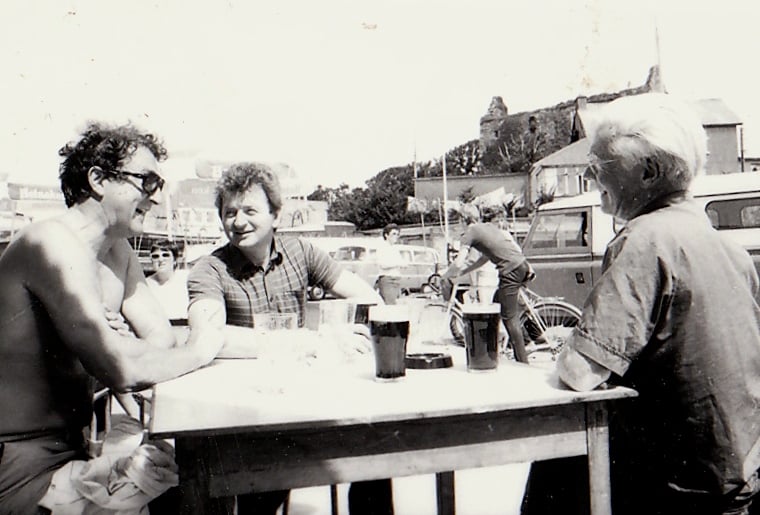 Putting the world to rights – Baltimore in the summer of 1984, with (left to right) Hugh Kennedy, Dom O’Flynn, Brendan Cassidy, and beyond him the castle, without its roof in those distant days. Photo: W M Nixon
Putting the world to rights – Baltimore in the summer of 1984, with (left to right) Hugh Kennedy, Dom O’Flynn, Brendan Cassidy, and beyond him the castle, without its roof in those distant days. Photo: W M Nixon
Memories, memories. Tom Fuller was indeed a lovely man, with vision ahead of his time. Thanks to Ger O’Flynn, we now know that way back in the 1930s, there was at least one person in Baltimore who appreciated that there was potentially much more to Albert than a nuisance who consumed vast quantities of fish.
As for that remembered gathering in the sunshine in Baltimore, it was 1984, and we were in West Cork with our visit built around the Centenary of Schull Regatta which was in the midst of the West Cork Regattas when they were in more traditional form. Thus Ger and his late brother Dom (who also served as a BSC Commodore) were in the throes of preparation for Baltimore Regatta on the Bank Holiday Monday, but “urgency” acquires a more relaxed meaning in summertime in Baltimore, and though Ger had nipped away to sort some little problems when I took the photo of Hugh Kennedy, Dom O’Flynn and Brendan Cassidy of Howth undoubtedly putting the world to rights in the sunshine, everything took place as expected.
It was something of a miracle we were there at all, as mid-July bad seen us handling the Press Office at ISORA Week, then we’d set off with our little Hustler 30 Turtle for an ambitious cruise taking in southwest Wales including inveigling our way ashore on the monastic island of Caldey, a night at Lundy in the midst of the Bristol Channel, round Land’s End for a few days in Falmouth where the family were on holiday, a proper little visit to the Isles of Scilly, and then nor’west to West Cork and suddenly there we were, on the quay in Baltimore, and a full plenary session in place.
Even at Schull Centenary Regatta when the wind failed completely, it was no problem - they decided that Michael O’Leary of Dun Laoghaire with the Holland 39 classic Imp had clearly been shaping up to be the winner, so they simply moved the finishing line out to the completely becalmed Imp by dropping the outer mark on one side of Imp, then taking the committee boat round to the other, and then firing the gun to make him line honours and corrected time winner.
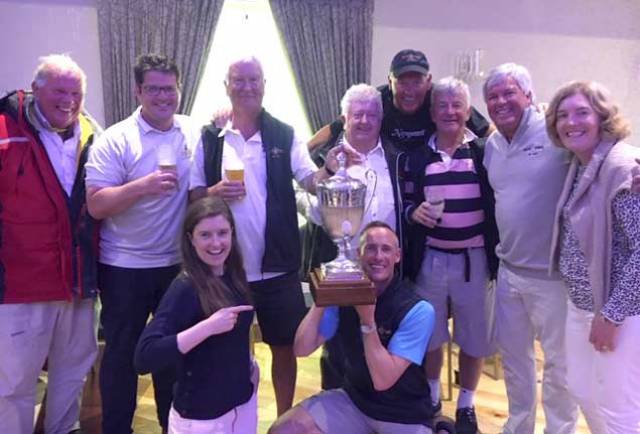 Still at it. Michael O’Leary (centre) in the midst of his shipmates after winning overall with the Dufour 44 Act Two in the 2019 Calves Week White Sails Division, thirty-five years after winning the Schull Centenary Regatta at the same venue with Imp
Still at it. Michael O’Leary (centre) in the midst of his shipmates after winning overall with the Dufour 44 Act Two in the 2019 Calves Week White Sails Division, thirty-five years after winning the Schull Centenary Regatta at the same venue with Imp
There were memories of all this last year when the same Michael O’Leary and partners were the White Sail overall winners at Calves Week in Schull with the Dufour 44 Act Two, but for me the sweetest memories of 1984 are of Cape Clear Regatta, which was organised by the late Derek Harte and his many friends with their “Cape Clear Advanced Regatta Computer”.
To everyone else, the Computer looked like a cardboard box with a tape coming out of it, with a long row of adhesive labels on the tape, each with the name of one of the entered boats. All of us got a prize of an attractive piece of locally-fired pottery. But as Teddy Crosbie had sailed a blinder with his Sadler 32, he rightly got the Pope Cup for the overall winner, and all was well with the world.
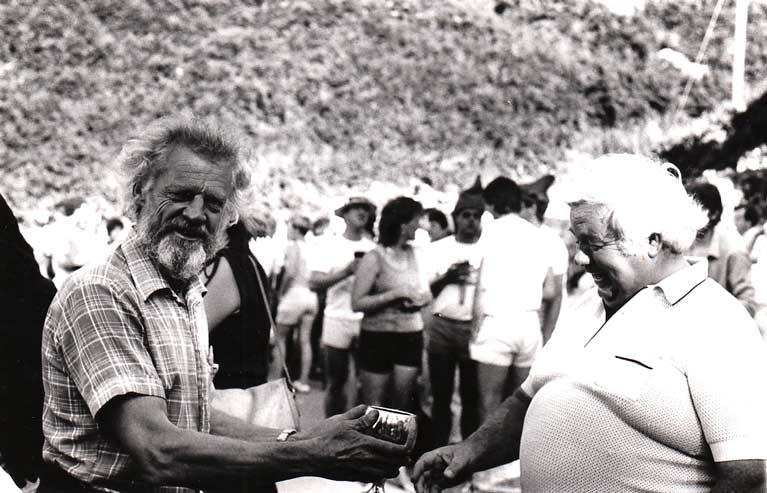 Derek Harte (left) presents Teddy Crosby with the Pope Cup for overall champion, Cape Clear Regatta 1984. Photo: W M Nixon
Derek Harte (left) presents Teddy Crosby with the Pope Cup for overall champion, Cape Clear Regatta 1984. Photo: W M Nixon
And if we have strayed more than somewhat from whether or not, once upon a time, there was a creature of significance in the seas around Baltimore called Albert, and whether or not he was a dolphin or a pilot whale or whatever, well so be it, that’s the way it is with West Cork.
Eoghan Harris defends Afloat's WM Nixon over reader criticism of his recent article on life in the West Cork village in April
Sir,
Donna McCarthy, who wrote complaining about W.M Nixon’s light-hearted piece about Baltimore, should offer him an apology for three reasons.
First, Donna has no right to talk about Nixon getting things wrong. He is totally innocent of her main charge - that he wrote about a dog defecating on the street. He did not. Donna herself dreamed that up and is solely responsible for any adverse media comment that may arise from it. Accordingly, she owes both W.M Nixon and Baltimore an apology and not the other way round.
Second, Donna is clearly ignorant of the fact that WM Nixon adores Baltimore judging by his stunning 2014 article in Afloat, which covered the contribution of every local hero from the late Youen Jacob’s Cafe Brise, to Richard Bushe’s bar to Liam Hegarty’s boatyard. A link to this splendid narrative is here.
Finally, as I myself have written about every aspect of life in Baltimore since 1990, I want to say that W M Nixon has no master in writing about Irish maritime villages and towns. But in writing about Baltimore he kept his best wine to the last.
Eoghan Harris
Donna McCarthy acknowledged her error in interpreting Mr Nixon’s comments regarding the dog by way of a Facebook comment on April 8 here - Ed
Eoghan Harris is graceful in his defence of my position on the Dogs in the Streets of Baltimore, which is much appreciated, and particularly gallant in view of his current health circumstances, which would distract many a lesser man. Outsiders should be aware that we devoted drivers of Saab cars constitute a mutually supportive confraternity by comparison with which the Knights Templar are but a loose-knit rabble. W M Nixon
Resident 'Insulted' By View of Baltimore in Lockdown
Baltimore Resident Donna McCarthy was angered by Afloat's article West Cork Sailing Dreamtime – Some Day, Summer will Come Again
Dear Editor,
This is my first time writing to you, though I enjoy reading the articles in Afloat on a regular basis. When I received the regular update by email this morning, I opened it with interest as usual. My interest quickly turned to surprise and then anger when I read the “Coastal Notes” by WM Nixon.
As a Baltimore resident, I am highly insulted at the inaccurate condescension that was published in the aforementioned article. While we are a coastal village that enjoys the maritime recreational activities written about in your magazine and welcome our seasonal visitors with gusto each year, we are not all dependent on the sailors that visit during the summer months to entertain us and keep us occupied.
I feel it was highly inappropriate that during a national and global health crisis, Mr Nixon felt he should belittle the excellent efforts the residents of our community are making to stem the spread of the Coronavirus COVID-19. People’s lives are at risk and he writes, and you publish, in a national magazine that the Baltimore residents have nothing else to do but watch dogs defecate. I am confused as to why Mr Nixon feels the need to write an article about the fact that Baltimore residents are complying with Government Guidelines by staying at home, as are one-third of the global population at this time. Also, why is it that a journalist that writes about maritime matters feels he is suitably qualified to write a sociological study of a village, during a time he hasn’t even visited it himself (note this is an assumption that he is abiding by the rules and not travelling more than 2 km from his home).
I appreciate under the current circumstances of physical distancing it may be difficult for Mr Nixon to undertake the fact-checking that is required of journalists in this country, however, I would like to remind him, through you, of his obligation under the Code of Conduct adopted by the NUJ that “A journalist shall strive to ensure that the information he/she disseminates is fair and accurate, avoid the expression of comment and conjecture as established fact and falsification by distortion, selection or misrepresentation”. (This is assuming he has agreed to conduct his journalism in accordance with this code.)
To assist with offering a “fair and accurate” reflection of the activities of the residents in our village, I have set out a number of other activities that are currently taking place here:
- I am a solicitor working for a global financial services company and completed substantial multi-jurisdictional agreements while working from home in the centre of Baltimore village;
- My husband is a network design engineer for a UK telecoms company ensuring networks, including those required for the essential services, are continuing seamlessly;
- Parents are home-schooling their children while working full time remotely;
- Restaurants have adapted processes and are offering take away menus and delivery services, even where it was not provided for previously;
- Local crafts people are continuing to develop local art and crafts that will be sold online, and in physical shops when they re-open;
- The local grocery shop is remaining open and ensuring the village has sufficient food, fuel, and other household supplies;
- People are taking regular exercise within the permitted 2km area from their homes. This includes running, walking, swimming, cycling;
- Neighbours are delivering meals and grocery shopping to neighbours in need.
I could continue the list, but as I only have my short lunch break to write this email as I am extremely busy at work, I believe I have made my point on this matter. Suffice to say, daily activities of the people of Baltimore pretty much mirror those in other villages, towns and cities of this country, except for maybe we continue life with a better sea view than most.
On a final note, while I am not an animal expert but am the proud owner of a fourteen-year-old Staffordshire Bull Terrier, I would just like to highlight that I am not aware of anything unique about the bowel movements of our canine pets in this village, and if Mr Nixon’s contacts in the village have the time to make online wagers on the matter I would suggest they find a new hobby to make better use of their betting skills.
As a responsible editor of a well-respected magazine, I would hope you are now considering retracting the published article, offering an apology or at a minimum requesting the author to correct the inaccuracies. If you would like to include my concerns and this email to you in the publication, in particular, to be able to give a balanced and true reflection of the facts, I give you my permission to do so.
Yours etc
Donna McCarthy
Baltimore Resident
Editor's note: WM Nixon made no reference to defecating dogs in his original article. However, we regret the offence caused to readers in Baltimore by the piece, which was intended to be a light-hearted reminiscence about Baltimore, a town described by the writer in his earlier, linked article as a "sailing paradise". Clearly, it touched a raw nerve in these difficult times and we apologise to all who felt offended by it.
In locked-down Baltimore in West Cork, the word is that in current circumstances, the most exciting thing that happens during the day is when a dog walks past, taking its sniff-busy morning walk up the empty street. Everybody goes to their window to watch this major event until the canine inspector has disappeared from view, and then they return to the task in which they’d been engrossed.
Those who are making some semblance of working from home for the first time are learning that for most folk, it ceases to be home once you have to do some supposedly income-generating task within its walls. Those social commentators who are predicting that our ways of working will see a marked change once the current situation has got back to something approaching normality seem to be unaware of this inescapable fact. Completely separate work-places are necessary for most people to work. That’s all there is to it.
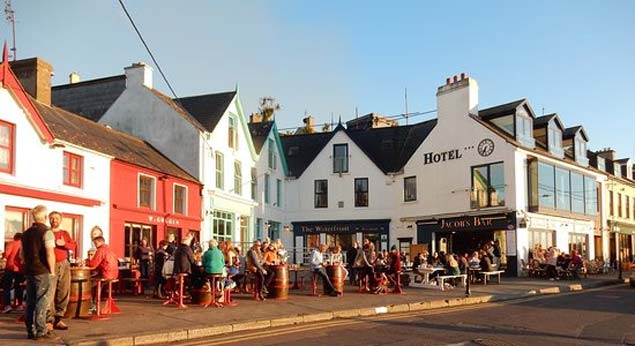 Baltimore in more normal times on a sunny summer evening. Currently, the height of the locked-in day’s excitement is when a solitary dog walks up the road
Baltimore in more normal times on a sunny summer evening. Currently, the height of the locked-in day’s excitement is when a solitary dog walks up the road
For sure, there are those of us who have always worked from home, but as one of them, I can assure you that it’s not a way of life for everyone. And the basic reason we earn a meagre crust in this way is that we probably lack the social skills to function in an interpersonal situation at some sort of work-station with anyone within anything remotely approaching today’s mandatory two-metre social distancing.
"the most exciting thing that happens during the day is when a dog walks past"
In fact, we don’t want anyone in the same room, and one other inhabitant within the same building is all that is required to hope that from time to time, a cup of coffee or tea might appear, or a clever light lunch gets effortlessly rustled together with a chance that it might be enjoyed in the suntrap down the garden.
That said, we’re lost in admiration for those techno-whizzes who have invented ways of making the whole business of being house-bound more entertaining, and it’s said that in Baltimore they’ve now got an online sweepstake running as to when certain dogs will take their daily dander up the street. I’ve no idea if it’s true that some rogue elements have taken to releasing cats into the empty streetscape in order to upset some gamblers’ carefully made observations and closely-calculated predictions. But in times like this, all’s fair for a spot of entertainment and distraction.
Because with Easter plumb in the middle of April where it should be on a permanent basis, and with good weather a real possibility, people are going up the walls in holiday sailing places which would normally be springing to fresh life this Friday. So just to sharpen the exquisite torture, at the end of this piece there’s a link to a Sailing on Saturday blog from 2014 which seemed to succeed in capturing the flavour of Baltimore on a sunny sailing weekend, for it received a gratifying global response.
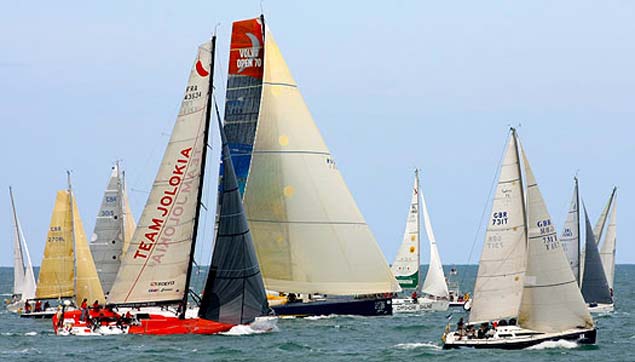 Typical start for the biennial Round Ireland Race from Wicklow. With nearly everything else announcing early cancellations for major events because of COVID-19, Wicklow SC are quite right to stay on track until the end of April, for it’s not as if anyone else will have an alternative programme in mind for June 20th
Typical start for the biennial Round Ireland Race from Wicklow. With nearly everything else announcing early cancellations for major events because of COVID-19, Wicklow SC are quite right to stay on track until the end of April, for it’s not as if anyone else will have an alternative programme in mind for June 20th
But before we go to it, let me just say that I think Wicklow Sailing Club is absolutely right in postponing until the end of April any decision on cancelling their 20th June Round Ireland Race. With every other major event falling over itself to cancel early, what alternative programme would potential Round Ireland Racers have in mind?
But enough of that – here’s Baltimore and West Cork in the summer of 2014, and though some things have changed, others are eternal in their charm.
Baltimore Lifeboat Launches To Fishing Vessel With Engine Difficulties
Baltimore RNLI was called out yesterday afternoon (Friday 20 December) to assist a fishing vessel in difficulty off the coast of the West Cork village.
The all-weather lifeboat was launched at 1.16pm at the request of the Irish Coast Guard to assist an 18m fishing vessel with two people onboard, that was experiencing engine problems some two nautical miles south of Baltimore Harbour.
Conditions at the time were moderate, with a south south-westerly Force 3-4 wind, two-metre sea swell and good visibility.
The lifeboat with six volunteer crew onboard reached the casualty vessel just over 20 minutes later. Once the crew had assessed the situation, they established a tow and brought the vessel back to Baltimore.
Baltimore’s inshore lifeboat launched with four crew members to assist with berthing the vessel at the north pier once they had entered the harbour.
Speaking following the callout, press officer Kate Callanan said: “Whilst there was no immediate danger to the crew on board, the skipper of the fishing vessel did the right thing in calling for assistance from the Irish Coast Guard.”
Optimist Spring Training Dates Set For 2020 In Baltimore
16-21 February are the dates to save for Optimist Spring Training at Baltimore Sailing Club in West Cork.
This year the class has teamed up with freelance dinghy performance coach Thomas Chaix to work collaboratively on training sessions to kick off the season — riding high on the international success of Oppy helms like Rocco Wright.
And at the end of the week the assembled Optimist sailors have their pre-trials regatta.
On the social side, IODAI has organised a movie night at Casey’s Hotel and an end-of-week disco with the opportunity for parents to relax and meet up for a meal.
Registration for 2020 Spring Training is now available online. For more details contact Mandy at [email protected] see the IODAI website.
Book Launch For Story Of Baltimore’s Lifeboat Next Saturday
RTÉ’s Fergal Keane will be at Baltimore Sailing Club next Saturday 7 December for the launch of a new book celebrating 100 years of the West Cork village’s RNLI lifeboat service.
Baltimore Lifeboat: A Community Story by Éamon Lankford is now available, priced €16, with all proceeds going to Baltimore RNLI.
Seascapes presenter Keane will be in attendance to host the official launch from 8pm next Saturday, and all are welcome to attend — while the author will be signing copies earlier that afternoon from 3pm to 4pm at Hickey’s newsagents in Skibbereen.
For details on how to get a copy of the book, contact [email protected]
Busy Weekend For West Cork Lifeboats In Baltimore & Courtmacsherry
Following last Thursday’s launch to a sailing dinghy aground on an island near Baltimore Harbour, the local RNLI crew were called out twice on Sunday (22 September), with the first to other boat aground in the harbour.
The inshore lifeboat was on scene in a matter of minutes after they were notified that the 14m sailing boat had run up on rocks at the harbour’s edge.
Volunteer crew set up a tow line to return the vessel to deeper water and, once it was checked over for damage, the lifeboat towed the yacht head to wind to let its crew set their sails.
Baltimore’s inshore lifeboat launched again at 3.36pm to assist a RIB with five people on board which broke down and was at anchor off Castle Point, near Schull Harbour.
However, while en route the lifeboat was stood down after word came through that the RIB’s occupants had managed to get themselves under way.
Elsewhere, in West Cork, Courtmacsherry’s all-weather lifeboat launched on Saturday evening (21 September) as bad weather unfolded to rescue a surfer in difficulty off Inchydoney.
As the lifeboat was speeding across Clonakilty Bay to the reported location, its crew were informed that the surfer had managed to get ashore safe and well.
Deputy launching authority Diarmuid O’Mahony praised those on shore who called for help for their quick alert: “Vital minutes today could have been so important in sea conditions that were very poor.
“I also want to commend all the volunteer crew who responded so quickly in coming to the lifeboat station in the knowledge that they were going to face some mountainous seas and difficult conditions off the coast.”
As previously reported, Crosshaven RNLI also launched yesterday to two sailors whose catamaran dinghy capsized in Cork Harbour yesterday evening.
Baltimore Lifeboat Launches To Sailing Vessel Ashore On Island
Two people were rescued by Baltimore RNLI yesterday afternoon (Thursday 19 September) after their sailing dinghy was stranded ashore on Spanish Island near the West Cork harbour.
The inshore lifeboat was on scene within minutes, and quickly established a tow to take the 14ft vessel off the rocks, Baltimore RNLI says.
After checking for damage, the sailboat and its sailors were bought back to the safety of the pier in Baltimore.
Speaking after the callout, Baltimore RNLI press officer Kate Callanan said: “The sailors did the right thing in asking for assistance as they were unsure of how to proceed once the boat had gone ashore.
“They were both wearing lifejackets and were carrying mobile phones which they used to call the coastguard to alert them of their situation.
:If you get into difficulty on the water or along the coast, call 999 or 112 and ask for the coastguard.”


























